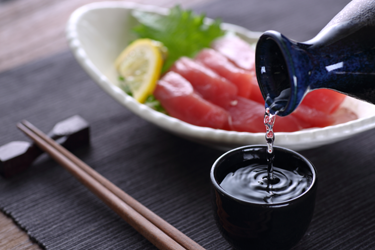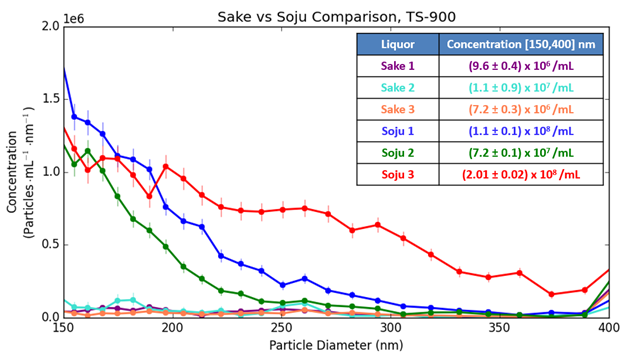July 30, 2020 – Saké or Soju?

Enjoy some sashimi with that (cold) saké!
Your dutiful correspondent was treated to a Japanese saké-tasting event while in Kyoto for the International Society of Extracellular Vesicles meeting in 2019. While the event was thoroughly enjoyable, all sakés tasted delicious to his unqualified tongue and he was left wishing for a more precise and quantitative metric with which to evaluate them.
Fortunately, Spectradyne’s applications team delivered! Three types of saké, a Japanese rice-based fermented beverage, and three types of soju, a Korean liquor that is also historically rice-based, were obtained and analyzed on the nCS1.
Personal allegiances aside, one key difference between saké and soju is that soju is traditionally distilled after fermentation, while saké is not. Based on these differences in manufacturing process, saké might reasonably be expected to contain a higher concentration of particles than soju: Distillation of soju would eliminate proteins and particles from the final product, resulting in lower particle concentration.
While a nice story, this hypothesis was NOT supported by the measurement results (see the measurement results below)! Liquor samples of the same type exhibited similar particle size distributions to each other, but the distilled soju samples contained 10-20 fold higher concentrations of particles than the saké. Curiously, soju sample 3 exhibited a stand-out particle size distribution from the other soju samples…
Check out the surprising difference between particle distributions in saké and soju. Read further to see why we think this data looks like this..
Following this confusing result, we discovered that most soju is in fact no longer distilled in the traditional fashion, instead it is made by diluting and flavoring ethanol made from sweet potatoes, thus providing a likely explanation for our surprising result! Next step: Correlating the observed differences to taste.
This experiment is part of our ongoing EveryDayTM nanoparticles series — read more details of the measurements here.
And if you’re in the liquor business (or any other of our application areas), send us a sample!
Please continue to follow our blog as we share insights, technical details, and generally geek-out with you about nanoparticle science!
Email us for more information, or to discuss your particular application directly.
